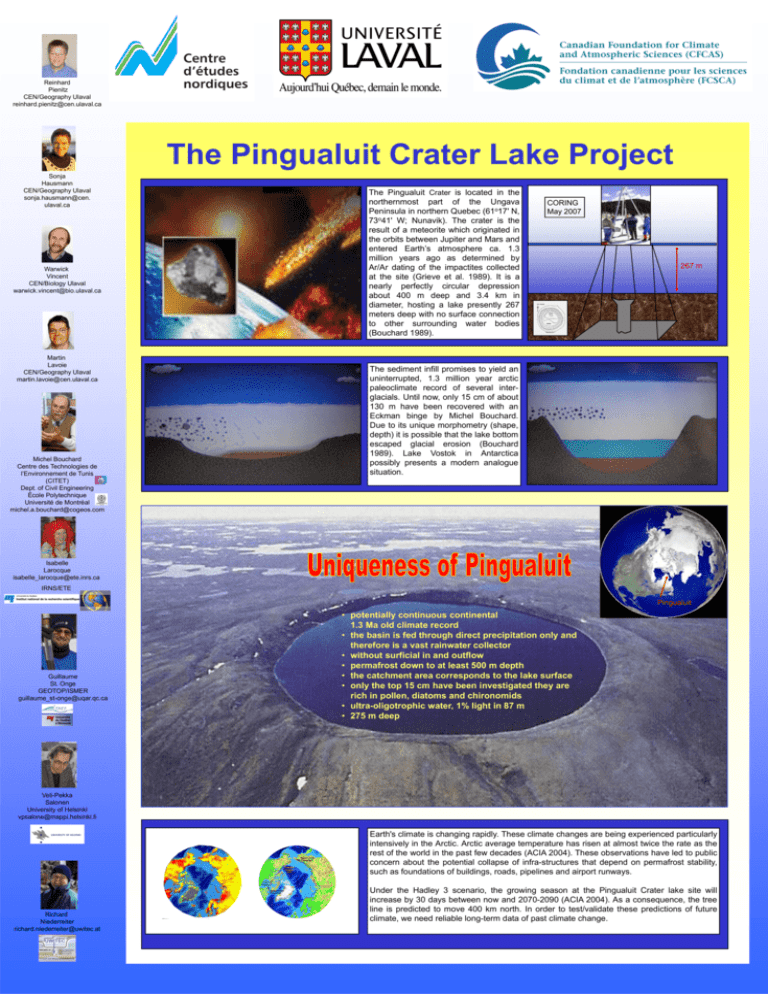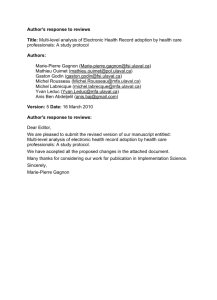to ppt file
advertisement

Reinhard Pienitz CEN/Geography Ulaval reinhard.pienitz@cen.ulaval.ca The Pingualuit Crater Lake Project Sonja Hausmann CEN/Geography Ulaval sonja.hausmann@cen. ulaval.ca The Pingualuit Crater is located in the northernmost part of the Ungava Peninsula in northern Quebec (61o17' N, 73o41' W; Nunavik). The crater is the result of a meteorite which originated in the orbits between Jupiter and Mars and entered Earth’s atmosphere ca. 1.3 million years ago as determined by Ar/Ar dating of the impactites collected at the site (Grieve et al. 1989). It is a nearly perfectly circular depression about 400 m deep and 3.4 km in diameter, hosting a lake presently 267 meters deep with no surface connection to other surrounding water bodies (Bouchard 1989). Warwick Vincent CEN/Biology Ulaval warwick.vincent@bio.ulaval.ca Martin Lavoie CEN/Geography Ulaval martin.lavoie@cen.ulaval.ca CORING May 2007 267 m The sediment infill promises to yield an uninterrupted, 1.3 million year arctic paleoclimate record of several interglacials. Until now, only 15 cm of about 130 m have been recovered with an Eckman binge by Michel Bouchard. Due to its unique morphometry (shape, depth) it is possible that the lake bottom escaped glacial erosion (Bouchard 1989). Lake Vostok in Antarctica possibly presents a modern analogue situation. Michel Bouchard Centre des Technologies de l’Environnement de Tunis (CITET) Dept. of Civil Engineering École Polytechnique Université de Montréal michel.a.bouchard@cogeos.com Isabelle Larocque isabelle_larocque@ete.inrs.ca IRNS/ETE Pingualuit • potentially continuous continental 1.3 Ma old climate record • the basin is fed through direct precipitation only and therefore is a vast rainwater collector • without surficial in and outflow • permafrost down to at least 500 m depth • the catchment area corresponds to the lake surface • only the top 15 cm have been investigated they are rich in pollen, diatoms and chironomids • ultra-oligotrophic water, 1% light in 87 m • 275 m deep Guillaume St. Onge GEOTOP/ISMER guillaume_st-onge@uqar.qc.ca Veli-Pekka Salonen University of Helsinki vpsalone@mappi.helsinki.fi Impact crater El'gygytgyn Projected Treeline 2090 Earth's climate is changing rapidly. These climate changes are being experienced particularly intensively in the Arctic. Arctic average temperature has risen at almost twice the rate as the rest of the world in the past few decades (ACIA 2004). These observations have led to public concern about the potential collapse of infra-structures that depend on permafrost stability, such as foundations of buildings, roads, pipelines and airport runways. Present Treeline Impact crater Pingualuit Richard Niederreiter richard.niederreiter@uwitec.at Under the Hadley 3 scenario, the growing season at the Pingualuit Crater lake site will increase by 30 days between now and 2070-2090 (ACIA 2004). As a consequence, the tree line is predicted to move 400 km north. In order to test/validate these predictions of future climate, we need reliable long-term data of past climate change.






